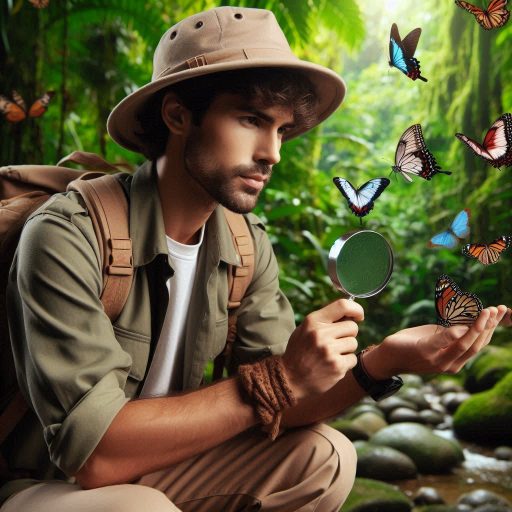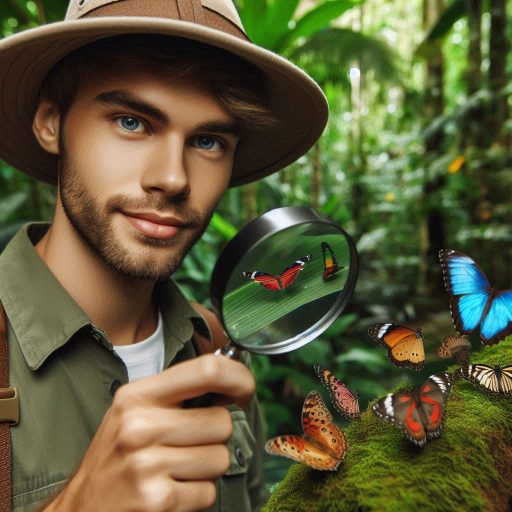Introduction
Zoologists study animals and their interactions with ecosystems.
They observe animal behavior, physiology, and habitats to understand biodiversity.
Their work contributes to conservation efforts and wildlife management.
By researching various species, zoologists help protect endangered animals and their environments.
Using tools and technologies is crucial in zoology research.
These instruments enable scientists to gather accurate data and analyze complex biological systems.
For example, GPS tracking devices provide insights into animal movements and migration patterns.
Similarly, camera traps allow researchers to monitor wildlife behavior without disturbing their natural habitats.
Technologies like Geographic Information Systems (GIS) help map animal habitats and study environmental impacts.
Drones offer new perspectives by surveying remote areas and tracking large populations.
DNA sequencing revolutionizes species identification and genetic studies.
Embracing modern tools enhances the effectiveness of zoological studies.
They empower researchers to make informed decisions regarding conservation and management strategies.
As the field evolves, zoologists must stay updated with technological advancements.
This ensures they can effectively address current challenges in wildlife research and conservation.
By integrating innovative tools, zoologists will continue to make significant contributions to science and the preservation of biodiversity.
Microscopes
Microscopes are essential tools for zoologists studying small organisms and tissues.
These instruments allow researchers to observe structures that are invisible to the naked eye.
Various types of microscopes serve different purposes in zoology.
Understanding these types can enhance the study of animal biology significantly.
Types of Microscopes Used by Zoologists
Light microscopes are the most common type used in zoology.
They utilize visible light to magnify specimens up to 1,000 times.
This type is ideal for viewing cells, tissues, and small organisms, such as protozoa.
Electron microscopes offer much higher magnification and resolution.
They use electron beams instead of light to visualize specimens.
Scanning electron microscopes (SEM) create detailed three-dimensional images of surface structures.
Transmission electron microscopes (TEM) provide insights into the internal structures of cells.
These microscopes can magnify specimens up to 2 million times, revealing intricate details.
Fluorescence microscopes are also popular among zoologists.
They use fluorescent dyes to highlight specific components within cells or tissues.
This technique allows scientists to observe cellular processes in real time.
Each microscope type has unique applications in zoology, enabling researchers to explore various biological phenomena.
How Microscopes Help in Studying Small Organisms and Tissues
Microscopes are crucial for studying small organisms, such as bacteria and protists.
They allow zoologists to examine the morphology and behavior of these organisms in detail.
By observing these small creatures, researchers can gather essential data about their life cycles and interactions.
Microscopes also play a vital role in studying animal tissues.
They help zoologists understand how cells function and interact within organisms.
This knowledge is crucial for fields like developmental biology and physiology.
Researchers can investigate how diseases affect tissues and organs using microscopy techniques.
Importance of High-Resolution Images in Zoology Research
High-resolution images are essential for accurate observations in zoology research.
They reveal minute details that can lead to new discoveries.
Detailed images help researchers identify species and understand their behaviors and interactions.
High-resolution microscopy can uncover structures like cell membranes and organelles.
These details provide insights into cellular functions and processes.
This information is vital for understanding how organisms adapt to their environments.
Furthermore, high-quality images are important for documentation and education.
They enhance scientific publications, presentations, and educational materials.
Clear visuals help communicate complex ideas effectively to both scientists and the public.
Microscopes are indispensable tools in zoology.
Their various types enable detailed studies of small organisms and tissues.
High-resolution images enhance our understanding of biological structures and functions.
As technology advances, microscopes will continue to play a crucial role in zoological research and discovery.
Read: The Future of Botany: Emerging Fields and Innovations
GPS tracking devices
GPS tracking devices have revolutionized how zoologists study animal movements.
These devices provide accurate location data, enabling researchers to monitor wildlife behavior in real time.
By understanding animal movements, scientists gain insights into migration patterns, habitat use, and social interactions.
Role of GPS Tracking Devices in Studying Animal Movements
GPS tracking devices record an animal’s location at set intervals.
This data reveals how animals navigate their environments.
Researchers can track movements over large areas, making it easier to study elusive or migratory species.
These devices help scientists understand how animals respond to environmental changes.
For example, tracking devices can reveal how habitat loss impacts migration routes.
By analyzing movement data, researchers can identify critical habitats that need protection.
Examples of Studies Where GPS Tracking Devices Have Been Used
Numerous studies have successfully utilized GPS tracking devices.
One notable example involves tracking sea turtles during their migrations.
Researchers fitted turtles with GPS devices to monitor their routes and understand nesting site selection.
Another study tracked the movements of wolves in Yellowstone National Park.
Scientists observed how wolves interacted with their prey and how they adapted to changes in their environment.
This research provided valuable insights into predator-prey dynamics.
Additionally, ornithologists often use GPS devices to track migratory birds.
By understanding flight paths and stopover sites, researchers can assess the impacts of climate change on bird populations.
These examples illustrate the versatility of GPS tracking devices across different animal species.
Benefits of Using GPS Tracking Devices in Zoology Research
The benefits of using GPS tracking devices in zoology research are significant.
First, these devices provide precise location data, enhancing the accuracy of movement studies.
Researchers can gather comprehensive datasets that reveal patterns over time.
Second, GPS devices enable long-term monitoring of animals.
Scientists can track individuals over extended periods, providing insights into their life stages and behaviors.
This information is crucial for understanding the effects of environmental factors on wildlife.
Third, GPS tracking devices facilitate research in remote or inaccessible areas.
Researchers can collect data without disturbing the animals, allowing for natural behavior observation.
This minimizes the impact of human presence on the study subjects.
Moreover, GPS data aids in conservation efforts.
By identifying critical habitats and migration routes, scientists can advocate for protective measures.
These insights inform land management decisions and support wildlife conservation initiatives.
GPS tracking devices have transformed zoological research.
They provide valuable data on animal movements and behaviors, offering insights into ecological dynamics.
The applications of GPS technology continue to expand, driving advancements in wildlife research and conservation efforts.
As technology evolves, GPS tracking will remain a vital tool for zoologists worldwide.
Read: What Does a Geologist Do? Career Overview and Insights
Camera traps
Camera traps are vital tools for monitoring animal behavior in their natural habitats.
These devices automatically capture images or videos when triggered by motion.
By using camera traps, researchers can study wildlife without causing disturbances.
This non-invasive method allows scientists to observe animals in their natural behaviors.
How Camera Traps Help in Monitoring Animal Behavior
Camera traps help scientists gather data on elusive and nocturnal species.
They record behaviors that would otherwise go unnoticed by human observers.
Researchers can analyze feeding habits, social interactions, and mating rituals.
This information is crucial for understanding species ecology and behavior.
Camera traps also enable long-term monitoring of animal populations.
By setting up multiple traps, scientists can capture data over extended periods.
This approach helps researchers identify population trends and movements.
They can track seasonal changes and migration patterns effectively.
Additionally, camera traps can document rare or endangered species.
This data is essential for assessing population sizes and distribution.
It helps conservationists develop targeted management strategies for at-risk animals.
Importance of Using Camera Traps in Wildlife Conservation
Camera traps play a significant role in wildlife conservation efforts.
They provide essential information needed for effective habitat management.
By understanding how animals use their environments, conservationists can make informed decisions.
This knowledge guides the creation of protected areas and wildlife corridors.
Furthermore, camera traps can help raise public awareness about wildlife conservation.
Captured images and videos engage the public and promote interest in local wildlife.
Conservation organizations often share these visuals through social media and educational programs.
This outreach fosters a connection between communities and their local ecosystems.
Camera traps also aid in monitoring illegal activities, such as poaching.
By placing cameras in critical areas, researchers can identify suspicious activities.
This information helps law enforcement agencies protect vulnerable species from illegal hunting.
Examples of Research Projects That Have Used Camera Traps
Many research projects have successfully utilized camera traps to study wildlife.
One notable project focused on jaguars in Central America.
Researchers used camera traps to document jaguar populations and their prey.
This study provided insights into the predator‘s role in the ecosystem.
Another project monitored the behavior of tigers in India.
Camera traps helped researchers understand tiger movements and habitat preferences.
This information is crucial for developing conservation strategies for this endangered species.
In a project in Africa, camera traps documented various wildlife species in a national park.
Researchers studied how human activities affected animal populations and behavior.
This research helped identify areas needing conservation efforts.
Camera traps are essential tools in wildlife research and conservation.
They allow scientists to monitor animal behavior non-invasively.
By providing valuable data, camera traps support effective conservation strategies.
The continued use of camera traps will enhance our understanding of wildlife and promote efforts to protect endangered species.
Read: Educational Path: Becoming a Geologist in the USA

DNA Sequencing
DNA sequencing has become a vital tool in zoology research.
It allows scientists to identify species and study genetic diversity accurately.
By analyzing DNA, researchers can uncover relationships between species and understand evolutionary processes.
This technology has revolutionized our understanding of biodiversity and conservation.
Importance of DNA Sequencing in Identifying Species and Studying Genetic Diversity
DNA sequencing plays a crucial role in species identification.
Traditional methods often rely on morphological characteristics, which can be misleading.
DNA sequencing provides a more reliable method for distinguishing closely related species.
This accuracy is essential in biodiversity assessments and ecological studies.
Additionally, DNA sequencing helps researchers study genetic diversity within populations.
Understanding genetic variation is vital for assessing population health and resilience.
It reveals how species adapt to environmental changes and survive challenges.
High genetic diversity often indicates a robust population capable of adapting to new conditions.
Examples of How DNA Sequencing Has Revolutionized Zoology Research
Numerous examples demonstrate how DNA sequencing has transformed zoology research.
One notable case involved the study of cryptic species, which are morphologically similar but genetically distinct.
By using DNA sequencing, scientists identified multiple previously unrecognized species.
This discovery has significant implications for conservation strategies.
Another example includes the sequencing of the genomes of various endangered species.
This research helps scientists understand the genetic basis of traits related to survival.
For instance, researchers sequenced the genome of the black-footed ferret to enhance conservation efforts.
They identified genetic factors that influence disease resistance, aiding breeding programs.
In marine biology, DNA sequencing has helped uncover the diversity of marine organisms.
Researchers sequenced environmental DNA (eDNA) from water samples to identify species present in ecosystems.
This method allows scientists to monitor biodiversity without capturing or observing organisms directly.
Benefits of Using DNA Sequencing Tools in Taxonomy and Conservation Biology
The benefits of DNA sequencing tools in taxonomy and conservation biology are immense.
First, these tools enable precise species identification, reducing misidentifications.
Accurate taxonomic classifications are essential for understanding ecosystems and implementing conservation measures.
Second, DNA sequencing aids in understanding evolutionary relationships among species.
By constructing phylogenetic trees, scientists can trace lineages and explore evolutionary history.
This knowledge informs conservation priorities and strategies.
Third, DNA sequencing supports the development of effective conservation programs.
Researchers can assess genetic diversity within and between populations.
This information guides breeding programs and habitat restoration efforts to maintain genetic health.
Moreover, DNA sequencing enhances wildlife monitoring efforts.
By analyzing genetic samples from populations, researchers can estimate population sizes and assess genetic health.
This data is critical for making informed conservation decisions.
DNA sequencing has revolutionized zoology research.
It enhances species identification, studies genetic diversity, and informs conservation efforts.
As technology advances, DNA sequencing will continue to play a pivotal role in understanding and preserving biodiversity.
Transform Your Career Today
Unlock a personalized career strategy that drives real results. Get tailored advice and a roadmap designed just for you.
Start NowRead: Botany Career Fairs and Networking Events
Drones
Drones have transformed wildlife surveys and monitoring in recent years.
These unmanned aerial vehicles (UAVs) provide researchers with new perspectives on animal populations.
Drones allow scientists to conduct surveys efficiently and accurately, minimizing disturbance to wildlife.
Their ability to cover vast areas makes them invaluable in zoology.
Role of Drones in Wildlife Surveys and Monitoring
Drones play a critical role in gathering data on wildlife populations.
They can capture high-resolution images and videos of animals in their habitats.
This technology enables researchers to monitor animal behavior and movement patterns from above.
Drones also facilitate the collection of data on habitat conditions and landscape changes.
Additionally, drones can conduct population assessments for hard-to-reach species.
Researchers can estimate population sizes and track changes over time.
This information is essential for effective conservation planning and management.
Benefits of Using Drones in Accessing Remote and Hard-to-Reach Areas
One major benefit of using drones is their ability to access remote areas.
Traditional methods often require extensive ground surveys, which can be time-consuming and labor-intensive.
Drones can quickly cover large expanses of terrain, saving time and resources.
Drones also reduce the risk of human disturbance to wildlife.
By observing animals from a distance, researchers can minimize stress and behavioral changes.
This non-invasive approach is especially important for studying sensitive species.
Furthermore, drones can reach areas that are difficult or dangerous for humans to access.
For example, researchers can survey rugged terrains or dense forests without putting themselves at risk.
This capability enhances data collection in challenging environments.
Examples of Research Projects That Have Utilized Drones in Zoology
Numerous research projects have successfully utilized drones in zoology.
One significant project focused on monitoring penguin populations in Antarctica.
Researchers used drones to count and observe penguins without disturbing their nesting sites.
This method provided accurate population estimates and insights into breeding success.
Another project involved surveying large mammals in African savannas.
Drones helped researchers track the movements of elephants and other wildlife across vast landscapes.
This information is crucial for understanding migration patterns and human-wildlife conflict.
In Australia, scientists employed drones to monitor reef ecosystems.
They assessed the health of coral reefs and the distribution of marine species.
This research aids conservation efforts to protect these vital ecosystems.
Drones have revolutionized wildlife surveys and monitoring.
Their ability to access remote areas, minimize disturbance, and gather high-quality data makes them essential tools in zoology.
Geographic Information Systems (GIS)
Geographic Information Systems (GIS) have become essential tools for zoologists.
GIS technology helps researchers map and analyze animal habitats effectively.
By integrating various data sources, GIS provides valuable insights into wildlife distribution and ecosystem dynamics.
This technology enhances our understanding of species‘ needs and behaviors.
How GIS Technology Helps in Mapping and Analyzing Animal Habitats
GIS technology assists researchers in creating detailed maps of animal habitats.
Scientists can visualize habitat features and analyze spatial relationships between species and their environments.
This mapping process identifies critical habitats and resources for various species.
Moreover, GIS allows researchers to overlay different datasets, such as land use and topography.
This capability reveals how environmental factors influence animal distribution.
For example, scientists can assess how habitat fragmentation affects wildlife movement and survival.
By understanding these dynamics, researchers can propose effective management strategies.
Importance of GIS in Studying the Impact of Climate Change on Wildlife
GIS plays a vital role in studying climate change effects on wildlife.
Researchers can analyze how changing climates alter habitats and species distributions.
By modeling potential climate scenarios, scientists predict future changes in animal populations and their habitats.
GIS helps track shifts in species ranges due to climate change.
For instance, researchers can observe how rising temperatures affect migration patterns.
This information is crucial for developing adaptive management plans to protect vulnerable species.
Additionally, GIS can identify areas most at risk from climate change.
By assessing habitat resilience and connectivity, scientists prioritize conservation efforts.
This proactive approach enables effective responses to the challenges posed by climate change.
Examples of Studies That Have Used GIS to Inform Conservation Efforts
Numerous studies have successfully employed GIS to inform conservation strategies.
One notable project involved tracking the habitat of the endangered Florida panther.
Researchers used GIS to analyze habitat suitability and movement corridors.
This information guided efforts to protect critical habitats and reduce road mortality.
Another example includes a study on sea turtles and their nesting habitats.
GIS helped scientists identify key nesting beaches and assess potential threats.
This knowledge informed conservation initiatives aimed at protecting these important sites.
In Africa, GIS technology has supported elephant conservation efforts.
Researchers analyzed movement patterns and habitat use to reduce human-wildlife conflict.
This approach allowed for the implementation of targeted conservation measures in high-risk areas.
GIS technology significantly enhances wildlife research and conservation efforts.
It aids in mapping animal habitats, studying climate change impacts, and informing management strategies.
As GIS continues to evolve, its applications in zoology will likely expand, providing critical insights for preserving biodiversity and supporting conservation initiatives.
Explore Further: Top Universities for Soil Science Programs
Conclusion
Essential tools and technologies significantly enhance zoology research.
Microscopes provide detailed images of small organisms, aiding in tissue analysis.
GPS tracking devices help monitor animal movements and behaviors effectively.
Camera traps capture wildlife activity, offering valuable insights into behavior and conservation.
DNA sequencing identifies species and studies genetic diversity, revolutionizing taxonomy and conservation biology.
Drones access remote areas for wildlife surveys, providing new perspectives on animal populations.
Geographic Information Systems (GIS) map habitats and analyze environmental impacts, particularly from climate change.
Incorporating these modern tools is crucial for advancing zoological studies.
They enable researchers to gather accurate data, enhancing our understanding of wildlife and ecosystems.
Aspiring zoologists should embrace these technologies to succeed in their careers.
By learning to use these tools effectively, they can contribute to conservation efforts and wildlife protection.
As technology evolves, the field of zoology will continue to grow.
Future zoologists will benefit from a strong foundation in these essential tools.
They will help address pressing environmental challenges, ensuring a sustainable future for wildlife and their habitats.
Embrace the tools available today and make a positive impact in the field of zoology.
[E-Books for Sale]
The Big Book of 500 High-Paying Jobs in America: Unlock Your Earning Potential
$19.99 • 500 High-Paying Jobs • 330 pages
Explore 500 high-paying jobs in America and learn how to boost your career, earn more, and achieve success!
See All 500 High-Paying Jobs of this E-Book
1001 Professions Without a Degree: High-Paying American Jobs You Can Start Now
$19.99 • 1001 Professions Without a Degree • 174 pages
Discover 1001 high-paying jobs without a degree! Unlock career tips, skills, and success strategies for just $19.99!




